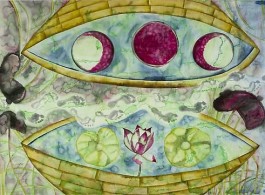[Press Release]
About Francesco Cclemente
Since the early 1970s the artist has continually traveled between Italy and India where many of the works in this current exhibition were made. He continued to travel to India, after settling in New York with his wife and family in 1980, where Clemente quickly became a vital member of the community of artists and writers. He collaborated with close friends, notably the poets Allen Ginsberg and Robert Creeley, and in 1981, reacting against a wave of anti-painting sentiment among critical circles, Clemente initiated a series of collaborative paintings with Jean-Michel Basquiat and Andy Warhol. The openness to collaborating with other artists combined with his experimental practices contributed to Clemente becoming a rising star of the international art world. His works were soon exhibited at both Documenta 7 in 1982 and the Venice Biennale in 1988, 1993, and again in 1995. Major solo museum exhibitions followed at the Nationalgalerie Berlin (1984), Centre Georges Pompidou, Paris (1994), Solomon R. Guggenheim Museum (1999), MADRE Museum, Naples (2009), and more recently at Schirn Kunsthalle, Frankfurt (2011) and Uffizi Gallery, Florence (2011). It has been said that Clemente’s conviction in his role as an artist is a kind of universal witness of consciousness. He came of age as an artist during a time when the call for a renewal of consciousness was the anthem of the day, which also points to the origins of his artistic inclinations: “The original impulse in my life as an artist,” Clemente has said, “was to write and to break from writing into image.” He has since then pursued arresting and indelible images which bring about an increased realization of the need to break with established notions of Self in order to expand awareness. This imperative, which continues, and his unflagging interest in philosophy and spirituality took Clemente to India for the first time in 1973. He would spend more than half of the 1970s, at irregular intervals, in the southern city of Madras, present day Chennai, and traveled extensively throughout the country. It was not long before Clemente set up a studio and had begun collaborating with local artists and exchange ideas with members of the Theosophical Society there. It can also be said that Clemente’s work and life continues to expands on multilayered records of experience, each place having its own influence on the works created at any given location, becoming an embarkation point for an ongoing visual memoir that encompasses simultaneously a profoundly personal and yet universal journey.
The works in this exhibition focus on Clemente’s masterful use of watercolor. On view are watercolors made in Varanasi, India in 2008, as well as recent large-scale watercolors created at the artist’s studio in New York last year in 2011. The Varanasi watercolors were made using as their basis cut-out stenciled silhouettes—open palms, feet, bells, vases, wings; a heart-shaped or pelvic shape or two human heads in mirrored profile. The scholar and critic Jyotindra Jain, whose engagement with Clemente’s work in India goes back for the past twenty years, has written extensively on these specific watercolors stating “Cutting out a stencil in the form of the outermost contouring elements, Clemente first replicated the silhouette of each of these forms on four or more sheets of paper. Empty of any content, these hollow forms provided a wondrous space to be filled with a repertoire of images—floating, melting, transforming, definite or tentative, single or in combination; pleasant or disquieting—stemming from his nebulous imagistic world.” Clemente is a true master of seriality, as Jain also cites, “who is fascinated by the literary and musical technique of improvisation on a theme.” These works on a formal level convey ideas of symmetry and duality, but also give space to intimate reflection, agility, and fluid gracefulness. The images of the palms and feet have a long tradition in both Buddhist and Hindu cultures as divine symbols of one’s destiny, auspiciousness and prosperity.



